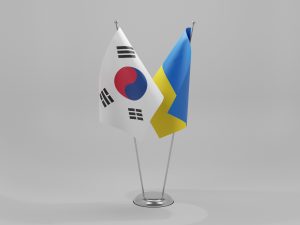The Russian invasion of Ukraine will have lingering impact on global security and international rule of law. South Korea is not immune from these consequences. But the most immediate effects of the war for South Korea will be economic. While commercial exchange with Ukraine constitutes a small fraction of South Korea’s overall international trade, the embattled Eastern European country is the leading supplier of inputs essential for semiconductor production. Going beyond what the war might mean for South Korea’s tech industry in the medium term, this represents another acute reminder of the vulnerability of South Korea’s economic model, which relies too heavily on merchandise exports and neglects services.
Outside highly-integrated common markets like the European Union, where members also share land borders, South Korea’s export-dependence is unique among economies of its size and maturity. Exports constituted over 32 percent of the country’s GDP in 2019. For comparison, the equivalent figure for the United States that year was 7.67 percent while Japan, which is perhaps too often mischaracterized as being export-dependent, stood at 13.93 percent.
One might intuitively conclude from these figures that South Korea’s principal geoeconomic risk stems from the danger of losing access to its export destinations. In actuality, the more looming threat in recent years proved to be on the import side with trade partners losing their ability (or willingness) to deliver key inputs to South Korean flagship export industries.
Korean firms have long navigated disruptions in key export destinations. Case in point, annual merchandise sales to Russia receded from $10.1 billion to $4.6 billion after Vladimir Putin annexed the Crimean Peninsula in 2014, sparking widespread sanctions – a significant blow given that Russia had been South Korea’s largest export destination in Europe since 2011. This drastic reduction in sales to the Russian market contributed to South Korea’s worldwide merchandise sales declining year-on-year in 2015 and 2016. Nonetheless, overall international export growth had rebounded by 2017.
Meanwhile, South Korean firms have had a more difficult time finding substitutes for inputs needed to produce key merchandise goods. For instance, Ukraine is a leading provider of noble gases that are used in lasers that print circuits on semiconductor chips – South Korea’s single largest export item. South Korea currently purchases 31 percent of its krypton from Ukraine, alongside 23 percent of its neon gas and 18 percent of its xenon. If the ongoing war disrupts output of these gases, finding a substitute will be difficult as Ukraine currently accounts for a dominant share of their global production (70 percent of the world’s neon gas production). Establishing domestic capacity to substitute imports will also be challenging as these noble gases are often byproducts of refined processes within heavy and chemical industries.
Seoul was not entirely caught off guard in this recent crisis. Neon gas prices had risen ten-fold during the 2014 Crimea crisis. Reeling from this experience, South Korea has been investing in building domestic capacity to reduce its import-dependence. Reports suggest that South Korean steelmaker POSCO may be able to fill 16 percent of domestic noble gas needs by the second half of this year. However, if the war becomes protracted, the domestic capacity coming online is not only misaligned in its timeline, with global chip companies reportedly holding only six-to-eight weeks of noble gas inventory, but also insufficient to substitute South Korea’s purchases from Ukraine.
South Korean firms faced a similar challenge in 2019 when Tokyo removed the country from a list of favored trade partners. Prior to this action, South Korea was exempted from intensive screenings by the Japanese government for the purchases of over 1,000 strategic products that had potential military applications. The most important import items affected by this exclusion were fluorinated polyimides, photoresists, and hydrogen fluoride – all essential components to South Korea’s semiconductor industry.
In response, chipmakers like Samsung established new partnerships with producers from different countries and began developing their own capacity to manufacture these chemicals. However, this is not a sustainable response. As the war in Ukraine demonstrates, the geoeconomic risks are increasingly omnidirectional. Short of onshoring the entire supply chain, a more robust and sustainable strategy needs to be pursued.
One path might lie in diversifying South Korea’s economic activities, with a particular emphasis on fostering the services industry. Unlike merchandise producers, businesses in the services industry are less circumscribed by material inputs and therefore can be more resilient when sudden shocks convulse the international flow of goods.
To achieve this, South Korea must focus on fostering small and medium enterprises, which currently make up an outsized share of the country’s services sector. Here, proactive government assistance could play an important role. Recent research by OECD economist Mathilde Pak and co-authors showed that Korean SMEs lag behind global peers in the adoption of productivity-enhancing tools like cloud computing. To address this gap, public financial assistance and skills training support might prove critical in jumpstarting this long-overshadowed sector of the economy.
Going forward, South Korea will likely confront greater international market instability. Domestic firms are responding by diversifying their input sources and production centers – most notably by moving manufacturing operations away from China. Achieving a greater balance between export of merchandise and services should also be part of this resilience-building effort. Greater sectoral diversity promises to not only create new jobs for an economy struggling to employ its labor force but also provide greater buffers in the face of growing geopolitical uncertainty.

































